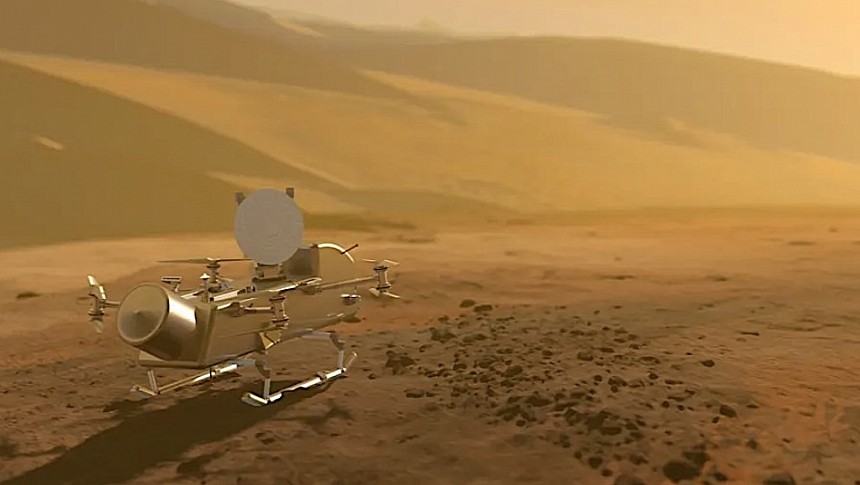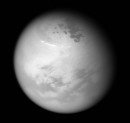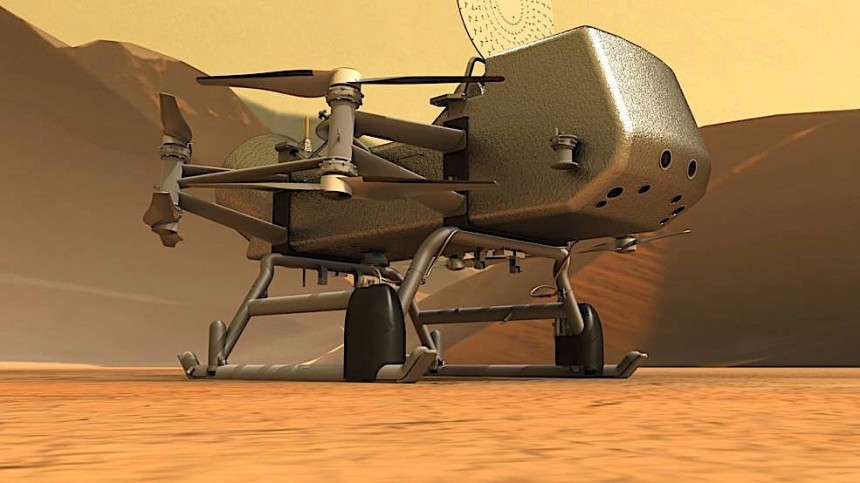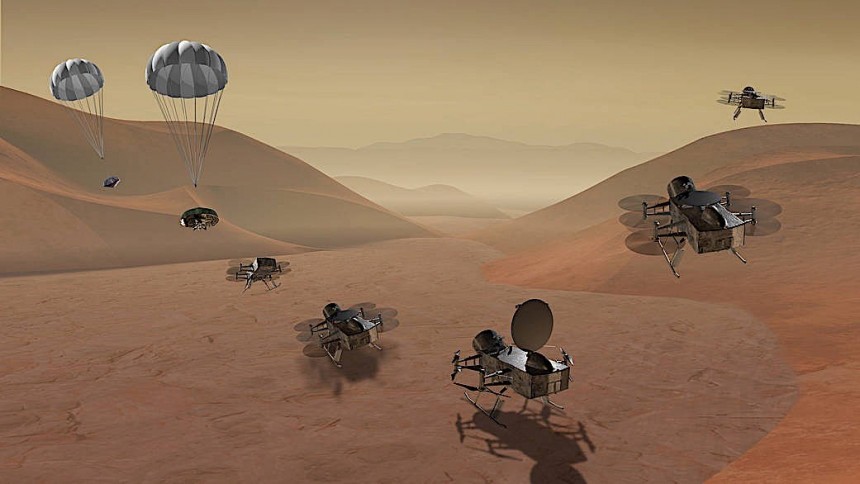There are many places in this solar system of ours where life in one form or another could exist, but few of them are as promising as a faraway moon called Titan. And, if all the stars align and next year's President's Budget Request approves, we'll soon go there to take a closer look.
Titan is a ball orbiting gas giant Saturn, and it's so big in kind of falls into the planet category. As the planet's largest moon, it is bigger than Mercury and comes second only to Jupiter's moon Ganymede in terms of size. And that's saying something, considering we've discovered more than 150 moons so far in our solar system so far.
But the above is not what makes Titan special. Of all the other moons out there, this is the only one that comes with a substantial atmosphere. Moreover, it is the only other place we know of in the neighborhood to have rivers, lakes and seas on its surface.
True, they are not rivers and seas made of water, but of methane and ethane. These hydrocarbons do not rule out the existence of life, though, and that's why the moon has become one of the centers of our species' attention.
To date, no dedicated mission was sent out there, but several other spacecraft did visit the place. Pioneer 11, Voyager 1 and 2, all made flybys as they headed deeper into space in the 1970s and 1980s. More recently, in 2005, a European mission called Cassini dropped a probe called Huygens onto its surface.
All of the above pale in comparison to what NASA has planned next. Under the umbrella term Dragonfly, the space agency is developing an entirely new vehicle that will study the surface of Titan in a way that was never attempted before on an alien world: by hopping.
The spacecraft has been designed as a dual-quadcopter (or an octocopter, if you will) that looks eerily close to the design of modern-day drones we use here on Earth. The thing is supposed to land in one place, collect samples, and do science, and then move on to an entirely new place to start the process all over again.
In the works for a while now, the mission to Titan was officially confirmed in 2019, and rapidly moved through its various stages of development. The research culminated earlier this year with the completion of the Preliminary Design Review. And it seemed like all was on track for the planned launch in 2027.
Last week NASA announced the Dragonfly mission to Titan is a go for final mission design and fabrication, something that should happen over the course of the 2024 fiscal year. Despite this apparent good news, though, the mission is not technically cleared yet.
The space agency said it is "postponing formal confirmation of the mission" until after the release of the 2025 President's Budget Request, something that will happen in the middle of next year. It is then that we'll also learn how much NASA expects the Dragonfly effort to cost. As a result of that, the launch date has been pushed back one year, to 2028.
If it does happen (and we are of course rooting for it), Dragonfly may forever change the way alien world exploration is done.
Even today, decades after we've started heading out into the solar system, the technologies we have in place only allow for observation from orbit, or sampling of very limited areas located near some rovers' landing sites.
The incredible success of the Ingenuity helicopter over on Mars is what fueled ideas of such devices being deployed elsewhere for exploration. Unlike a rover, which is limited by the technology it packs in terms of speed and reach, a helicopter-style machine can move further, faster, and achieve a lot more.
The Dragonfly will mark the first time we've employed "a rotorcraft-lander to travel between and sample diverse sites."
The Titan mission has three main goals. The first is to see if the moon is habitable, like we believe it to be. Then, it will look at the progression of prebiotic chemistry there, especially given how it is believed "carbon-rich material and liquid water may have mixed for an extended period."
Finally, Dragonfly will try to see if there are any chemical indications of whether water-based or hydrocarbon-based life once existed on surface of the Moon.
We don't know the full details of the mission yet, but we do know NASA targets a region of the world known as Shangri-La – a region we see from down here as a dark place, but may turn out to be a true paradise of discovery.
Once there, Dragonfly will repeatedly take off and land. At the end of the mission, the distance traveled from the landing site should be as large as 108 miles (175 km), which is something no other man-made off-world explorer was able to achieve in a short period of time.
But the above is not what makes Titan special. Of all the other moons out there, this is the only one that comes with a substantial atmosphere. Moreover, it is the only other place we know of in the neighborhood to have rivers, lakes and seas on its surface.
True, they are not rivers and seas made of water, but of methane and ethane. These hydrocarbons do not rule out the existence of life, though, and that's why the moon has become one of the centers of our species' attention.
To date, no dedicated mission was sent out there, but several other spacecraft did visit the place. Pioneer 11, Voyager 1 and 2, all made flybys as they headed deeper into space in the 1970s and 1980s. More recently, in 2005, a European mission called Cassini dropped a probe called Huygens onto its surface.
All of the above pale in comparison to what NASA has planned next. Under the umbrella term Dragonfly, the space agency is developing an entirely new vehicle that will study the surface of Titan in a way that was never attempted before on an alien world: by hopping.
In the works for a while now, the mission to Titan was officially confirmed in 2019, and rapidly moved through its various stages of development. The research culminated earlier this year with the completion of the Preliminary Design Review. And it seemed like all was on track for the planned launch in 2027.
Last week NASA announced the Dragonfly mission to Titan is a go for final mission design and fabrication, something that should happen over the course of the 2024 fiscal year. Despite this apparent good news, though, the mission is not technically cleared yet.
The space agency said it is "postponing formal confirmation of the mission" until after the release of the 2025 President's Budget Request, something that will happen in the middle of next year. It is then that we'll also learn how much NASA expects the Dragonfly effort to cost. As a result of that, the launch date has been pushed back one year, to 2028.
If it does happen (and we are of course rooting for it), Dragonfly may forever change the way alien world exploration is done.
Even today, decades after we've started heading out into the solar system, the technologies we have in place only allow for observation from orbit, or sampling of very limited areas located near some rovers' landing sites.
The Dragonfly will mark the first time we've employed "a rotorcraft-lander to travel between and sample diverse sites."
The Titan mission has three main goals. The first is to see if the moon is habitable, like we believe it to be. Then, it will look at the progression of prebiotic chemistry there, especially given how it is believed "carbon-rich material and liquid water may have mixed for an extended period."
Finally, Dragonfly will try to see if there are any chemical indications of whether water-based or hydrocarbon-based life once existed on surface of the Moon.
We don't know the full details of the mission yet, but we do know NASA targets a region of the world known as Shangri-La – a region we see from down here as a dark place, but may turn out to be a true paradise of discovery.
Once there, Dragonfly will repeatedly take off and land. At the end of the mission, the distance traveled from the landing site should be as large as 108 miles (175 km), which is something no other man-made off-world explorer was able to achieve in a short period of time.








